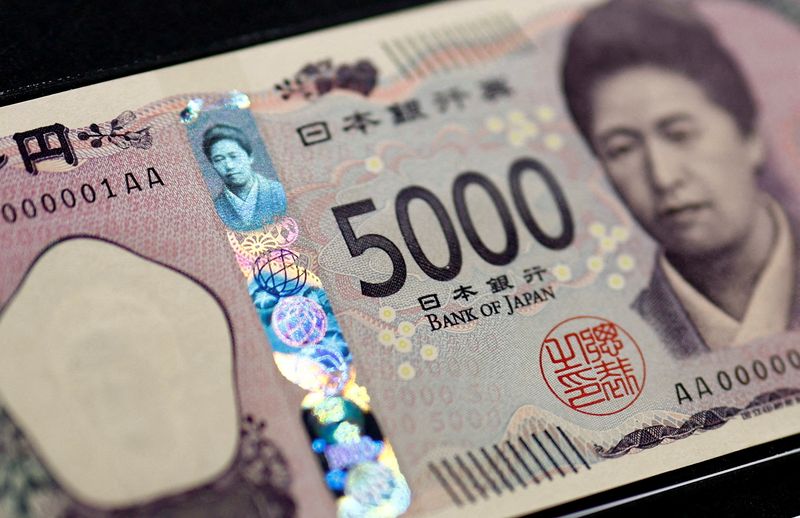By Kevin Buckland
TOKYO (Reuters) -The dollar sank to a three-week trough against the yen on Monday as Federal Reserve Chair Jerome Powell’s emphatic dovish shift contrasted sharply with Bank of Japan chief Kazuo Ueda’s steadfastly hawkish tone.
The U.S. currency hovered near its lowest in 13 months against the euro, and sagged closer to levels last seen in March 2022 versus sterling, with Bank of England head Andrew Bailey’s comments that it was “too early to declare victory” over inflation signaling a less aggressive stance on interest rate cuts than the Fed.
The dollar slumped as much 0.66% to 143.45 yen for the first time since Aug. 5 before trading down 0.31% as of 0517 GMT.
Sterling eased slightly to $1.31995 after jumping as high as $1.32295 on Friday for the first time in 17 months.
Although Fed officials had sounded increasingly dovish in the lead up to the Fed’s annual Jackson Hole symposium, Powell on Friday “used stronger language” than his peers when delivering his keynote speech, said Tapas Strickland, head of market economics at National Australia Bank (OTC:NABZY).
“Importantly, there was a notable absence of caveats such as ‘gradual/gradualism’,” effectively keeping the door open to larger rate-cut increments, which “is likely what excited markets,” Strickland said.
Earlier Friday, in parliamentary testimony in Tokyo, Ueda “stuck to the script of the BOJ needing to adjust the degree of easing – central bank-speak for a further increase in the policy rate from a low level – and he played down the significance of the July rate hike on market turmoil,” Strickland said.
Many market participants anticipated Ueda might strike a less hawkish tone in the special session of parliament, which was called amid criticism the surprise hike last month helped spark a rapid unwind of bearish yen bets and aggressive sell-off of Japanese stocks.
Traders unanimously expect the Fed to kick off its loosening campaign on Sept. 18, but see 38.5% odds of a super-sized 50-basis point reduction, according to the CME Group’s (NASDAQ:CME) FedWatch Tool. That’s up from 25% odds a week earlier.
The BoE’s Bailey also spoke at Jackson Hole, cementing the British central bank’s position as less dovish than the Fed and European Central Bank.
Sources told Reuters that ECB policy makers are lining up behind another rate cut on Sept. 12. Even so, the euro was little changed at $1.1184, not far from its Friday high of $1.1201, a level last seen in July of last year.
The dollar index – which measures the currency against a basket of six major peers, including the euro, sterling, yen and Swiss franc – languished at 100.69, just off the 13-month low of 100.60 reached at the end of last week.
The Swissie edged up about 0.1% to 0.8472 per dollar, and earlier touched 0.8457, the strongest level since Aug. 5.
The Chinese yuan ticked down slightly to 7.1202 per dollar in offshore trading, after beginning the day by rising as much as 0.13% to 7.1069, the strongest level since Aug. 5.
The People’s Bank of China (PBOC) set the official midpoint rate, around which the onshore yuan is allowed to trade in a 2% band, at 7.1139 per dollar, its strongest since June 13, although it was 7 pips weaker than a Reuters’ estimate.
“The CNY fixing mechanism seems to be reverting to be market forces-driven, shifting the focus (to) demand-supply dynamics and the USD movements,” said Ken Cheung, director of FX strategy at Mizuho Securities in Hong Kong.
“Market sensitivity to incoming China data … is expected to pick up.”
Elsewhere, the Australian dollar retreated 0.31% to $0.6776, but remained not far from Friday’s peak of $0.67985, the highest level since July 11.
Leading cryptocurrency bitcoin added 0.4% to $63,960.
